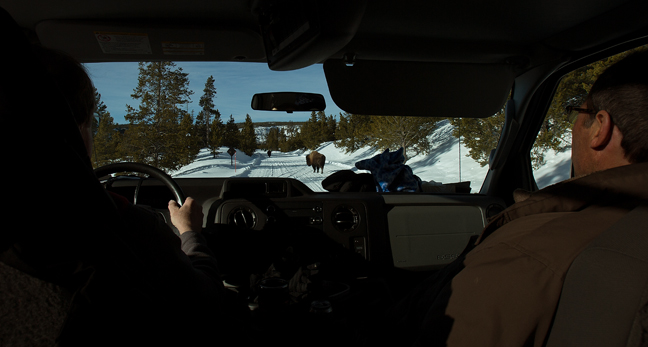

January 2017: Sharing the Road with Wayne and John, Yellowstone National Park
For five months every year, beginning in mid-November, the roads in Yellowstone National Park are snow packed and open only to foot traffic, snowmobiles and a variety of snowcoach configurations, including two 1953 Bombardiers, descendants of the original 1939 Canadian Snowbus patented by J. Armand Bombardier that resemble elongated red lady bugs.
These days access by motorized vehicles is strictly controlled. The current guidelines allow for 110 ‘transportation events’ daily, defined as one snowcoach or a group of up to 10 snowmobiles. Up to 50 transportation events may be groups of snowmobiles. During the week of January 30, when I visited the Park for five days, temperatures ranged from -16 to 28 °F and snow conditions varied from large delicate flakes to whiteout conditions that limited mobility and access. It was my first winter visit to the Park. The scenery was stunning, although there were more rules than necessary and the serenity was too often interrupted by parades of snowmobiles.
Bison are the most visible mammal species in the park and also a source of controversy. On February 2, 2017, Montana Gov. Steve Bullock lifted a temporary ban on the plan to kill up to 1,300 of the Park’s 5,500 bison that had been in place to protect bison that migrate out of the Park. The slaughter is intended to prevent bison from transmitting brucellosis to cattle, although no transmission from wild bison to livestock has ever been recorded. An agreement signed in 2000 by the state and the federal government set a population goal of 3,000 bison in the Park. Although, a bison eats about 24 pounds of forage a day, there are approximately 85,000 acres of grassland in the Park, so a lack of food can’t be the reason for controlling the population at that level. Even though the harvested meat feeds local indigenous communities, it’s difficult to emotionally separate the Park’s wild herd from those raised on the surrounding bison ranches if both are to be harvested.
Although the Park is home to ten packs of wolves and between 300-600 brown bears, most of the photographs you’ll see of these species are taken at the Grizzly & Wolf Discovery Center in West Yellowstone, adjacent to the Park’s western gate. Most photo groups spend a morning at the Center where pairs of bears are rotated through display areas for feeding and photographers hope for heavy snow that will obscure background fences from being visible in their pictures. There’s nothing ethically wrong with photographing captive or baited animals, but it often results in a credibility issue when those photographs are published without a disclaimer. The Center is a worthy non-profit with an excellent museum, just not a place to photograph realistic behaviors.
Within the Park, it’s easier to track wolves in the winter when their tracks are frozen into the snow, but all of the brown bears are hibernating. Yellowstone has a sordid past in bear management. For almost a century, beginning in the late 1800’s, brown bears gathered at night before bleachers packed with tourists to feed on garbage in open pit dumps behind Park hotels and, until the 1960s, visitors were allowed to feed begging opportunistic black bears along Park roads. This practice continued until 1970.
The Park is a much different place today and during the winter you only have to share it with 500-1,000 people a day, compared to July when almost 30,000 people visit the Park daily. Considering that the Park contains 3,472 square miles and all except the highest passes are open, that means that each winter visitor has an average of at least 347 square miles to him or herself. That’s a lot of real estate to explore in the world’s oldest national park.
©Rich Beckman
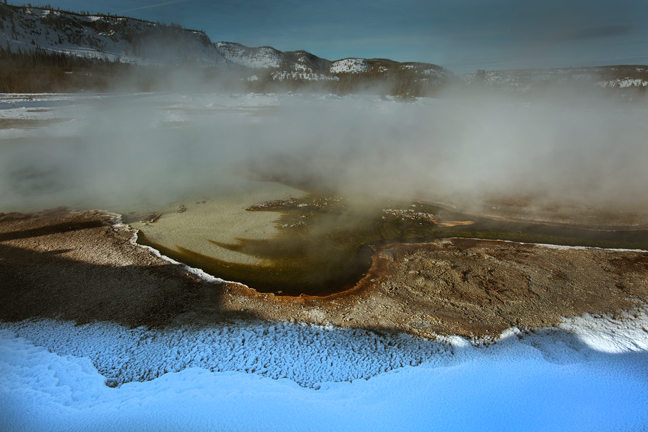

January 2017: Thermal Area, Yellowstone National Park
For five months every year, beginning in mid-November, the roads in Yellowstone National Park are snow packed and open only to foot traffic, snowmobiles and a variety of snowcoach configurations, including two 1953 Bombardiers, descendants of the original 1939 Canadian Snowbus patented by J. Armand Bombardier that resemble elongated red lady bugs.
These days access by motorized vehicles is strictly controlled. The current guidelines allow for 110 ‘transportation events’ daily, defined as one snowcoach or a group of up to 10 snowmobiles. Up to 50 transportation events may be groups of snowmobiles. During the week of January 30, when I visited the Park for five days, temperatures ranged from -16 to 28 °F and snow conditions varied from large delicate flakes to whiteout conditions that limited mobility and access. It was my first winter visit to the Park. The scenery was stunning, although there were more rules than necessary and the serenity was too often interrupted by parades of snowmobiles.
Bison are the most visible mammal species in the park and also a source of controversy. On February 2, 2017, Montana Gov. Steve Bullock lifted a temporary ban on the plan to kill up to 1,300 of the Park’s 5,500 bison that had been in place to protect bison that migrate out of the Park. The slaughter is intended to prevent bison from transmitting brucellosis to cattle, although no transmission from wild bison to livestock has ever been recorded. An agreement signed in 2000 by the state and the federal government set a population goal of 3,000 bison in the Park. Although, a bison eats about 24 pounds of forage a day, there are approximately 85,000 acres of grassland in the Park, so a lack of food can’t be the reason for controlling the population at that level. Even though the harvested meat feeds local indigenous communities, it’s difficult to emotionally separate the Park’s wild herd from those raised on the surrounding bison ranches if both are to be harvested.
Although the Park is home to ten packs of wolves and between 300-600 brown bears, most of the photographs you’ll see of these species are taken at the Grizzly & Wolf Discovery Center in West Yellowstone, adjacent to the Park’s western gate. Most photo groups spend a morning at the Center where pairs of bears are rotated through display areas for feeding and photographers hope for heavy snow that will obscure background fences from being visible in their pictures. There’s nothing ethically wrong with photographing captive or baited animals, but it often results in a credibility issue when those photographs are published without a disclaimer. The Center is a worthy non-profit with an excellent museum, just not a place to photograph realistic behaviors.
Within the Park, it’s easier to track wolves in the winter when their tracks are frozen into the snow, but all of the brown bears are hibernating. Yellowstone has a sordid past in bear management. For almost a century, beginning in the late 1800’s, brown bears gathered at night before bleachers packed with tourists to feed on garbage in open pit dumps behind Park hotels and, until the 1960s, visitors were allowed to feed begging opportunistic black bears along Park roads. This practice continued until 1970.
The Park is a much different place today and during the winter you only have to share it with 500-1,000 people a day, compared to July when almost 30,000 people visit the Park daily. Considering that the Park contains 3,472 square miles and all except the highest passes are open, that means that each winter visitor has an average of at least 347 square miles to him or herself. That’s a lot of real estate to explore in the world’s oldest national park.
©Rich Beckman
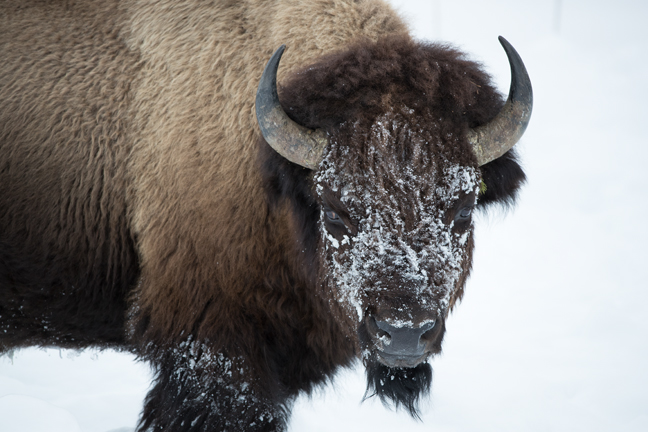

January 2017: Bison, Yellowstone National Park
For five months every year, beginning in mid-November, the roads in Yellowstone National Park are snow packed and open only to foot traffic, snowmobiles and a variety of snowcoach configurations, including two 1953 Bombardiers, descendants of the original 1939 Canadian Snowbus patented by J. Armand Bombardier that resemble elongated red lady bugs.
These days access by motorized vehicles is strictly controlled. The current guidelines allow for 110 ‘transportation events’ daily, defined as one snowcoach or a group of up to 10 snowmobiles. Up to 50 transportation events may be groups of snowmobiles. During the week of January 30, when I visited the Park for five days, temperatures ranged from -16 to 28 °F and snow conditions varied from large delicate flakes to whiteout conditions that limited mobility and access. It was my first winter visit to the Park. The scenery was stunning, although there were more rules than necessary and the serenity was too often interrupted by parades of snowmobiles.
Bison are the most visible mammal species in the park and also a source of controversy. On February 2, 2017, Montana Gov. Steve Bullock lifted a temporary ban on the plan to kill up to 1,300 of the Park’s 5,500 bison that had been in place to protect bison that migrate out of the Park. The slaughter is intended to prevent bison from transmitting brucellosis to cattle, although no transmission from wild bison to livestock has ever been recorded. An agreement signed in 2000 by the state and the federal government set a population goal of 3,000 bison in the Park. Although, a bison eats about 24 pounds of forage a day, there are approximately 85,000 acres of grassland in the Park, so a lack of food can’t be the reason for controlling the population at that level. Even though the harvested meat feeds local indigenous communities, it’s difficult to emotionally separate the Park’s wild herd from those raised on the surrounding bison ranches if both are to be harvested.
Although the Park is home to ten packs of wolves and between 300-600 brown bears, most of the photographs you’ll see of these species are taken at the Grizzly & Wolf Discovery Center in West Yellowstone, adjacent to the Park’s western gate. Most photo groups spend a morning at the Center where pairs of bears are rotated through display areas for feeding and photographers hope for heavy snow that will obscure background fences from being visible in their pictures. There’s nothing ethically wrong with photographing captive or baited animals, but it often results in a credibility issue when those photographs are published without a disclaimer. The Center is a worthy non-profit with an excellent museum, just not a place to photograph realistic behaviors.
Within the Park, it’s easier to track wolves in the winter when their tracks are frozen into the snow, but all of the brown bears are hibernating. Yellowstone has a sordid past in bear management. For almost a century, beginning in the late 1800’s, brown bears gathered at night before bleachers packed with tourists to feed on garbage in open pit dumps behind Park hotels and, until the 1960s, visitors were allowed to feed begging opportunistic black bears along Park roads. This practice continued until 1970.
The Park is a much different place today and during the winter you only have to share it with 500-1,000 people a day, compared to July when almost 30,000 people visit the Park daily. Considering that the Park contains 3,472 square miles and all except the highest passes are open, that means that each winter visitor has an average of at least 347 square miles to him or herself. That’s a lot of real estate to explore in the world’s oldest national park.
©Rich Beckman


January 2017: Old Faithful, Yellowstone National Park
For five months every year, beginning in mid-November, the roads in Yellowstone National Park are snow packed and open only to foot traffic, snowmobiles and a variety of snowcoach configurations, including two 1953 Bombardiers, descendants of the original 1939 Canadian Snowbus patented by J. Armand Bombardier that resemble elongated red lady bugs.
These days access by motorized vehicles is strictly controlled. The current guidelines allow for 110 ‘transportation events’ daily, defined as one snowcoach or a group of up to 10 snowmobiles. Up to 50 transportation events may be groups of snowmobiles. During the week of January 30, when I visited the Park for five days, temperatures ranged from -16 to 28 °F and snow conditions varied from large delicate flakes to whiteout conditions that limited mobility and access. It was my first winter visit to the Park. The scenery was stunning, although there were more rules than necessary and the serenity was too often interrupted by parades of snowmobiles.
Bison are the most visible mammal species in the park and also a source of controversy. On February 2, 2017, Montana Gov. Steve Bullock lifted a temporary ban on the plan to kill up to 1,300 of the Park’s 5,500 bison that had been in place to protect bison that migrate out of the Park. The slaughter is intended to prevent bison from transmitting brucellosis to cattle, although no transmission from wild bison to livestock has ever been recorded. An agreement signed in 2000 by the state and the federal government set a population goal of 3,000 bison in the Park. Although, a bison eats about 24 pounds of forage a day, there are approximately 85,000 acres of grassland in the Park, so a lack of food can’t be the reason for controlling the population at that level. Even though the harvested meat feeds local indigenous communities, it’s difficult to emotionally separate the Park’s wild herd from those raised on the surrounding bison ranches if both are to be harvested.
Although the Park is home to ten packs of wolves and between 300-600 brown bears, most of the photographs you’ll see of these species are taken at the Grizzly & Wolf Discovery Center in West Yellowstone, adjacent to the Park’s western gate. Most photo groups spend a morning at the Center where pairs of bears are rotated through display areas for feeding and photographers hope for heavy snow that will obscure background fences from being visible in their pictures. There’s nothing ethically wrong with photographing captive or baited animals, but it often results in a credibility issue when those photographs are published without a disclaimer. The Center is a worthy non-profit with an excellent museum, just not a place to photograph realistic behaviors.
Within the Park, it’s easier to track wolves in the winter when their tracks are frozen into the snow, but all of the brown bears are hibernating. Yellowstone has a sordid past in bear management. For almost a century, beginning in the late 1800’s, brown bears gathered at night before bleachers packed with tourists to feed on garbage in open pit dumps behind Park hotels and, until the 1960s, visitors were allowed to feed begging opportunistic black bears along Park roads. This practice continued until 1970.
The Park is a much different place today and during the winter you only have to share it with 500-1,000 people a day, compared to July when almost 30,000 people visit the Park daily. Considering that the Park contains 3,472 square miles and all except the highest passes are open, that means that each winter visitor has an average of at least 347 square miles to him or herself. That’s a lot of real estate to explore in the world’s oldest national park.
©Rich Beckman
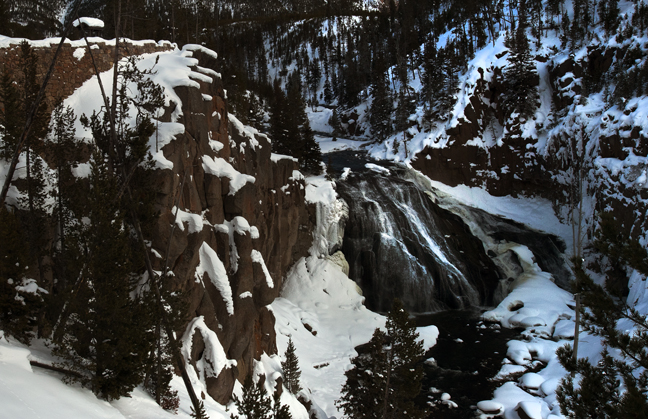

January 2017: Gibbon Falls, Yellowstone National Park
For five months every year, beginning in mid-November, the roads in Yellowstone National Park are snow packed and open only to foot traffic, snowmobiles and a variety of snowcoach configurations, including two 1953 Bombardiers, descendants of the original 1939 Canadian Snowbus patented by J. Armand Bombardier that resemble elongated red lady bugs.
These days access by motorized vehicles is strictly controlled. The current guidelines allow for 110 ‘transportation events’ daily, defined as one snowcoach or a group of up to 10 snowmobiles. Up to 50 transportation events may be groups of snowmobiles. During the week of January 30, when I visited the Park for five days, temperatures ranged from -16 to 28 °F and snow conditions varied from large delicate flakes to whiteout conditions that limited mobility and access. It was my first winter visit to the Park. The scenery was stunning, although there were more rules than necessary and the serenity was too often interrupted by parades of snowmobiles.
Bison are the most visible mammal species in the park and also a source of controversy. On February 2, 2017, Montana Gov. Steve Bullock lifted a temporary ban on the plan to kill up to 1,300 of the Park’s 5,500 bison that had been in place to protect bison that migrate out of the Park. The slaughter is intended to prevent bison from transmitting brucellosis to cattle, although no transmission from wild bison to livestock has ever been recorded. An agreement signed in 2000 by the state and the federal government set a population goal of 3,000 bison in the Park. Although, a bison eats about 24 pounds of forage a day, there are approximately 85,000 acres of grassland in the Park, so a lack of food can’t be the reason for controlling the population at that level. Even though the harvested meat feeds local indigenous communities, it’s difficult to emotionally separate the Park’s wild herd from those raised on the surrounding bison ranches if both are to be harvested.
Although the Park is home to ten packs of wolves and between 300-600 brown bears, most of the photographs you’ll see of these species are taken at the Grizzly & Wolf Discovery Center in West Yellowstone, adjacent to the Park’s western gate. Most photo groups spend a morning at the Center where pairs of bears are rotated through display areas for feeding and photographers hope for heavy snow that will obscure background fences from being visible in their pictures. There’s nothing ethically wrong with photographing captive or baited animals, but it often results in a credibility issue when those photographs are published without a disclaimer. The Center is a worthy non-profit with an excellent museum, just not a place to photograph realistic behaviors.
Within the Park, it’s easier to track wolves in the winter when their tracks are frozen into the snow, but all of the brown bears are hibernating. Yellowstone has a sordid past in bear management. For almost a century, beginning in the late 1800’s, brown bears gathered at night before bleachers packed with tourists to feed on garbage in open pit dumps behind Park hotels and, until the 1960s, visitors were allowed to feed begging opportunistic black bears along Park roads. This practice continued until 1970.
The Park is a much different place today and during the winter you only have to share it with 500-1,000 people a day, compared to July when almost 30,000 people visit the Park daily. Considering that the Park contains 3,472 square miles and all except the highest passes are open, that means that each winter visitor has an average of at least 347 square miles to him or herself. That’s a lot of real estate to explore in the world’s oldest national park.
©Rich Beckman
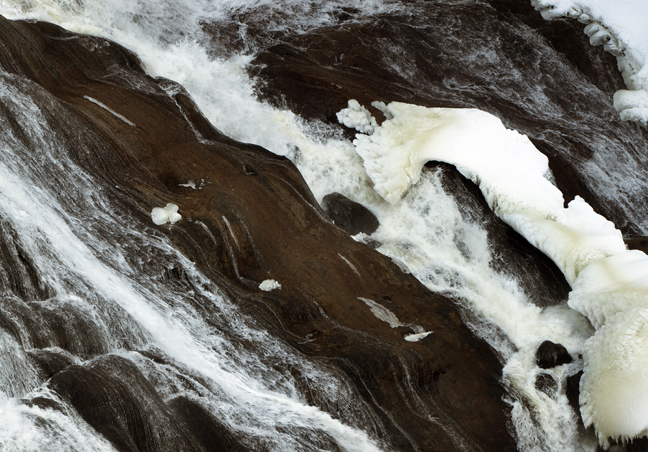

January 2017: Gibbon Falls, Yellowstone National Park
For five months every year, beginning in mid-November, the roads in Yellowstone National Park are snow packed and open only to foot traffic, snowmobiles and a variety of snowcoach configurations, including two 1953 Bombardiers, descendants of the original 1939 Canadian Snowbus patented by J. Armand Bombardier that resemble elongated red lady bugs.
These days access by motorized vehicles is strictly controlled. The current guidelines allow for 110 ‘transportation events’ daily, defined as one snowcoach or a group of up to 10 snowmobiles. Up to 50 transportation events may be groups of snowmobiles. During the week of January 30, when I visited the Park for five days, temperatures ranged from -16 to 28 °F and snow conditions varied from large delicate flakes to whiteout conditions that limited mobility and access. It was my first winter visit to the Park. The scenery was stunning, although there were more rules than necessary and the serenity was too often interrupted by parades of snowmobiles.
Bison are the most visible mammal species in the park and also a source of controversy. On February 2, 2017, Montana Gov. Steve Bullock lifted a temporary ban on the plan to kill up to 1,300 of the Park’s 5,500 bison that had been in place to protect bison that migrate out of the Park. The slaughter is intended to prevent bison from transmitting brucellosis to cattle, although no transmission from wild bison to livestock has ever been recorded. An agreement signed in 2000 by the state and the federal government set a population goal of 3,000 bison in the Park. Although, a bison eats about 24 pounds of forage a day, there are approximately 85,000 acres of grassland in the Park, so a lack of food can’t be the reason for controlling the population at that level. Even though the harvested meat feeds local indigenous communities, it’s difficult to emotionally separate the Park’s wild herd from those raised on the surrounding bison ranches if both are to be harvested.
Although the Park is home to ten packs of wolves and between 300-600 brown bears, most of the photographs you’ll see of these species are taken at the Grizzly & Wolf Discovery Center in West Yellowstone, adjacent to the Park’s western gate. Most photo groups spend a morning at the Center where pairs of bears are rotated through display areas for feeding and photographers hope for heavy snow that will obscure background fences from being visible in their pictures. There’s nothing ethically wrong with photographing captive or baited animals, but it often results in a credibility issue when those photographs are published without a disclaimer. The Center is a worthy non-profit with an excellent museum, just not a place to photograph realistic behaviors.
Within the Park, it’s easier to track wolves in the winter when their tracks are frozen into the snow, but all of the brown bears are hibernating. Yellowstone has a sordid past in bear management. For almost a century, beginning in the late 1800’s, brown bears gathered at night before bleachers packed with tourists to feed on garbage in open pit dumps behind Park hotels and, until the 1960s, visitors were allowed to feed begging opportunistic black bears along Park roads. This practice continued until 1970.
The Park is a much different place today and during the winter you only have to share it with 500-1,000 people a day, compared to July when almost 30,000 people visit the Park daily. Considering that the Park contains 3,472 square miles and all except the highest passes are open, that means that each winter visitor has an average of at least 347 square miles to him or herself. That’s a lot of real estate to explore in the world’s oldest national park.
©Rich Beckman
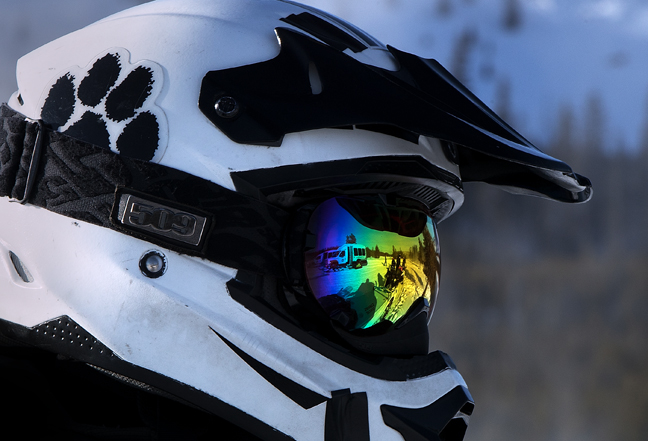

January 2017: Reflection, Snow Coach and Snowmobile, Yellowstone National Park
For five months every year, beginning in mid-November, the roads in Yellowstone National Park are snow packed and open only to foot traffic, snowmobiles and a variety of snowcoach configurations, including two 1953 Bombardiers, descendants of the original 1939 Canadian Snowbus patented by J. Armand Bombardier that resemble elongated red lady bugs.
These days access by motorized vehicles is strictly controlled. The current guidelines allow for 110 ‘transportation events’ daily, defined as one snowcoach or a group of up to 10 snowmobiles. Up to 50 transportation events may be groups of snowmobiles. During the week of January 30, when I visited the Park for five days, temperatures ranged from -16 to 28 °F and snow conditions varied from large delicate flakes to whiteout conditions that limited mobility and access. It was my first winter visit to the Park. The scenery was stunning, although there were more rules than necessary and the serenity was too often interrupted by parades of snowmobiles.
Bison are the most visible mammal species in the park and also a source of controversy. On February 2, 2017, Montana Gov. Steve Bullock lifted a temporary ban on the plan to kill up to 1,300 of the Park’s 5,500 bison that had been in place to protect bison that migrate out of the Park. The slaughter is intended to prevent bison from transmitting brucellosis to cattle, although no transmission from wild bison to livestock has ever been recorded. An agreement signed in 2000 by the state and the federal government set a population goal of 3,000 bison in the Park. Although, a bison eats about 24 pounds of forage a day, there are approximately 85,000 acres of grassland in the Park, so a lack of food can’t be the reason for controlling the population at that level. Even though the harvested meat feeds local indigenous communities, it’s difficult to emotionally separate the Park’s wild herd from those raised on the surrounding bison ranches if both are to be harvested.
Although the Park is home to ten packs of wolves and between 300-600 brown bears, most of the photographs you’ll see of these species are taken at the Grizzly & Wolf Discovery Center in West Yellowstone, adjacent to the Park’s western gate. Most photo groups spend a morning at the Center where pairs of bears are rotated through display areas for feeding and photographers hope for heavy snow that will obscure background fences from being visible in their pictures. There’s nothing ethically wrong with photographing captive or baited animals, but it often results in a credibility issue when those photographs are published without a disclaimer. The Center is a worthy non-profit with an excellent museum, just not a place to photograph realistic behaviors.
Within the Park, it’s easier to track wolves in the winter when their tracks are frozen into the snow, but all of the brown bears are hibernating. Yellowstone has a sordid past in bear management. For almost a century, beginning in the late 1800’s, brown bears gathered at night before bleachers packed with tourists to feed on garbage in open pit dumps behind Park hotels and, until the 1960s, visitors were allowed to feed begging opportunistic black bears along Park roads. This practice continued until 1970.
The Park is a much different place today and during the winter you only have to share it with 500-1,000 people a day, compared to July when almost 30,000 people visit the Park daily. Considering that the Park contains 3,472 square miles and all except the highest passes are open, that means that each winter visitor has an average of at least 347 square miles to him or herself. That’s a lot of real estate to explore in the world’s oldest national park.
©Rich Beckman
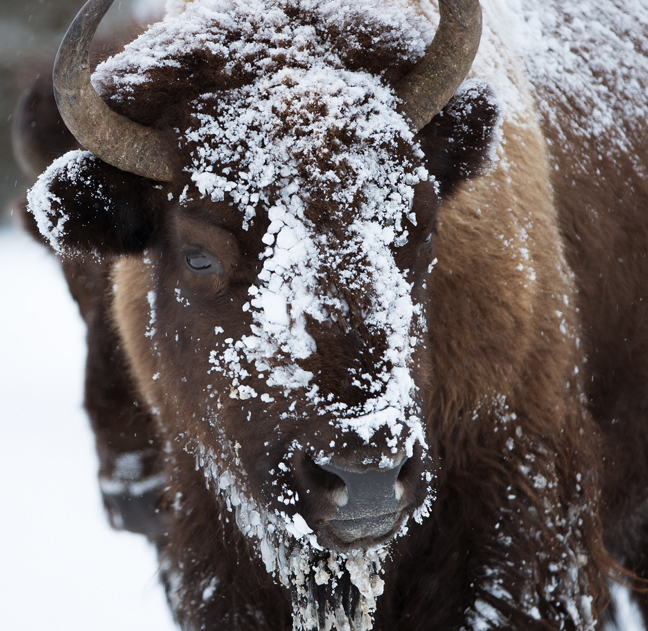

January 2017: Bison, Yellowstone National Park
For five months every year, beginning in mid-November, the roads in Yellowstone National Park are snow packed and open only to foot traffic, snowmobiles and a variety of snowcoach configurations, including two 1953 Bombardiers, descendants of the original 1939 Canadian Snowbus patented by J. Armand Bombardier that resemble elongated red lady bugs.
These days access by motorized vehicles is strictly controlled. The current guidelines allow for 110 ‘transportation events’ daily, defined as one snowcoach or a group of up to 10 snowmobiles. Up to 50 transportation events may be groups of snowmobiles. During the week of January 30, when I visited the Park for five days, temperatures ranged from -16 to 28 °F and snow conditions varied from large delicate flakes to whiteout conditions that limited mobility and access. It was my first winter visit to the Park. The scenery was stunning, although there were more rules than necessary and the serenity was too often interrupted by parades of snowmobiles.
Bison are the most visible mammal species in the park and also a source of controversy. On February 2, 2017, Montana Gov. Steve Bullock lifted a temporary ban on the plan to kill up to 1,300 of the Park’s 5,500 bison that had been in place to protect bison that migrate out of the Park. The slaughter is intended to prevent bison from transmitting brucellosis to cattle, although no transmission from wild bison to livestock has ever been recorded. An agreement signed in 2000 by the state and the federal government set a population goal of 3,000 bison in the Park. Although, a bison eats about 24 pounds of forage a day, there are approximately 85,000 acres of grassland in the Park, so a lack of food can’t be the reason for controlling the population at that level. Even though the harvested meat feeds local indigenous communities, it’s difficult to emotionally separate the Park’s wild herd from those raised on the surrounding bison ranches if both are to be harvested.
Although the Park is home to ten packs of wolves and between 300-600 brown bears, most of the photographs you’ll see of these species are taken at the Grizzly & Wolf Discovery Center in West Yellowstone, adjacent to the Park’s western gate. Most photo groups spend a morning at the Center where pairs of bears are rotated through display areas for feeding and photographers hope for heavy snow that will obscure background fences from being visible in their pictures. There’s nothing ethically wrong with photographing captive or baited animals, but it often results in a credibility issue when those photographs are published without a disclaimer. The Center is a worthy non-profit with an excellent museum, just not a place to photograph realistic behaviors.
Within the Park, it’s easier to track wolves in the winter when their tracks are frozen into the snow, but all of the brown bears are hibernating. Yellowstone has a sordid past in bear management. For almost a century, beginning in the late 1800’s, brown bears gathered at night before bleachers packed with tourists to feed on garbage in open pit dumps behind Park hotels and, until the 1960s, visitors were allowed to feed begging opportunistic black bears along Park roads. This practice continued until 1970.
The Park is a much different place today and during the winter you only have to share it with 500-1,000 people a day, compared to July when almost 30,000 people visit the Park daily. Considering that the Park contains 3,472 square miles and all except the highest passes are open, that means that each winter visitor has an average of at least 347 square miles to him or herself. That’s a lot of real estate to explore in the world’s oldest national park.
©Rich Beckman


January 2017: Coyote, Yellowstone National Park
For five months every year, beginning in mid-November, the roads in Yellowstone National Park are snow packed and open only to foot traffic, snowmobiles and a variety of snowcoach configurations, including two 1953 Bombardiers, descendants of the original 1939 Canadian Snowbus patented by J. Armand Bombardier that resemble elongated red lady bugs.
These days access by motorized vehicles is strictly controlled. The current guidelines allow for 110 ‘transportation events’ daily, defined as one snowcoach or a group of up to 10 snowmobiles. Up to 50 transportation events may be groups of snowmobiles. During the week of January 30, when I visited the Park for five days, temperatures ranged from -16 to 28 °F and snow conditions varied from large delicate flakes to whiteout conditions that limited mobility and access. It was my first winter visit to the Park. The scenery was stunning, although there were more rules than necessary and the serenity was too often interrupted by parades of snowmobiles.
Bison are the most visible mammal species in the park and also a source of controversy. On February 2, 2017, Montana Gov. Steve Bullock lifted a temporary ban on the plan to kill up to 1,300 of the Park’s 5,500 bison that had been in place to protect bison that migrate out of the Park. The slaughter is intended to prevent bison from transmitting brucellosis to cattle, although no transmission from wild bison to livestock has ever been recorded. An agreement signed in 2000 by the state and the federal government set a population goal of 3,000 bison in the Park. Although, a bison eats about 24 pounds of forage a day, there are approximately 85,000 acres of grassland in the Park, so a lack of food can’t be the reason for controlling the population at that level. Even though the harvested meat feeds local indigenous communities, it’s difficult to emotionally separate the Park’s wild herd from those raised on the surrounding bison ranches if both are to be harvested.
Although the Park is home to ten packs of wolves and between 300-600 brown bears, most of the photographs you’ll see of these species are taken at the Grizzly & Wolf Discovery Center in West Yellowstone, adjacent to the Park’s western gate. Most photo groups spend a morning at the Center where pairs of bears are rotated through display areas for feeding and photographers hope for heavy snow that will obscure background fences from being visible in their pictures. There’s nothing ethically wrong with photographing captive or baited animals, but it often results in a credibility issue when those photographs are published without a disclaimer. The Center is a worthy non-profit with an excellent museum, just not a place to photograph realistic behaviors.
Within the Park, it’s easier to track wolves in the winter when their tracks are frozen into the snow, but all of the brown bears are hibernating. Yellowstone has a sordid past in bear management. For almost a century, beginning in the late 1800’s, brown bears gathered at night before bleachers packed with tourists to feed on garbage in open pit dumps behind Park hotels and, until the 1960s, visitors were allowed to feed begging opportunistic black bears along Park roads. This practice continued until 1970.
The Park is a much different place today and during the winter you only have to share it with 500-1,000 people a day, compared to July when almost 30,000 people visit the Park daily. Considering that the Park contains 3,472 square miles and all except the highest passes are open, that means that each winter visitor has an average of at least 347 square miles to him or herself. That’s a lot of real estate to explore in the world’s oldest national park.
©Rich Beckman
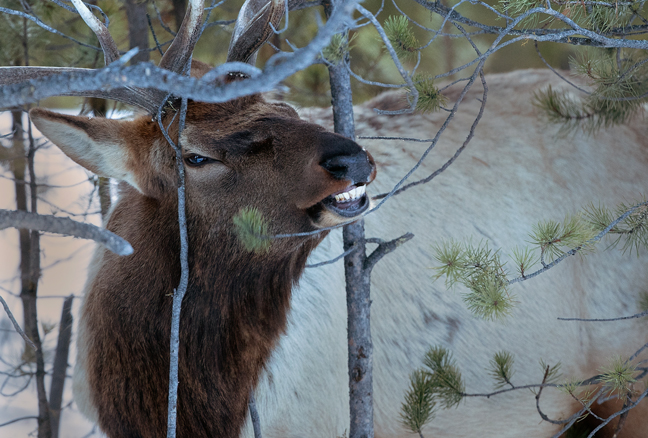

January 2017: Bull Elk, Yellowstone National Park
For five months every year, beginning in mid-November, the roads in Yellowstone National Park are snow packed and open only to foot traffic, snowmobiles and a variety of snowcoach configurations, including two 1953 Bombardiers, descendants of the original 1939 Canadian Snowbus patented by J. Armand Bombardier that resemble elongated red lady bugs.
These days access by motorized vehicles is strictly controlled. The current guidelines allow for 110 ‘transportation events’ daily, defined as one snowcoach or a group of up to 10 snowmobiles. Up to 50 transportation events may be groups of snowmobiles. During the week of January 30, when I visited the Park for five days, temperatures ranged from -16 to 28 °F and snow conditions varied from large delicate flakes to whiteout conditions that limited mobility and access. It was my first winter visit to the Park. The scenery was stunning, although there were more rules than necessary and the serenity was too often interrupted by parades of snowmobiles.
Bison are the most visible mammal species in the park and also a source of controversy. On February 2, 2017, Montana Gov. Steve Bullock lifted a temporary ban on the plan to kill up to 1,300 of the Park’s 5,500 bison that had been in place to protect bison that migrate out of the Park. The slaughter is intended to prevent bison from transmitting brucellosis to cattle, although no transmission from wild bison to livestock has ever been recorded. An agreement signed in 2000 by the state and the federal government set a population goal of 3,000 bison in the Park. Although, a bison eats about 24 pounds of forage a day, there are approximately 85,000 acres of grassland in the Park, so a lack of food can’t be the reason for controlling the population at that level. Even though the harvested meat feeds local indigenous communities, it’s difficult to emotionally separate the Park’s wild herd from those raised on the surrounding bison ranches if both are to be harvested.
Although the Park is home to ten packs of wolves and between 300-600 brown bears, most of the photographs you’ll see of these species are taken at the Grizzly & Wolf Discovery Center in West Yellowstone, adjacent to the Park’s western gate. Most photo groups spend a morning at the Center where pairs of bears are rotated through display areas for feeding and photographers hope for heavy snow that will obscure background fences from being visible in their pictures. There’s nothing ethically wrong with photographing captive or baited animals, but it often results in a credibility issue when those photographs are published without a disclaimer. The Center is a worthy non-profit with an excellent museum, just not a place to photograph realistic behaviors.
Within the Park, it’s easier to track wolves in the winter when their tracks are frozen into the snow, but all of the brown bears are hibernating. Yellowstone has a sordid past in bear management. For almost a century, beginning in the late 1800’s, brown bears gathered at night before bleachers packed with tourists to feed on garbage in open pit dumps behind Park hotels and, until the 1960s, visitors were allowed to feed begging opportunistic black bears along Park roads. This practice continued until 1970.
The Park is a much different place today and during the winter you only have to share it with 500-1,000 people a day, compared to July when almost 30,000 people visit the Park daily. Considering that the Park contains 3,472 square miles and all except the highest passes are open, that means that each winter visitor has an average of at least 347 square miles to him or herself. That’s a lot of real estate to explore in the world’s oldest national park.
©Rich Beckman
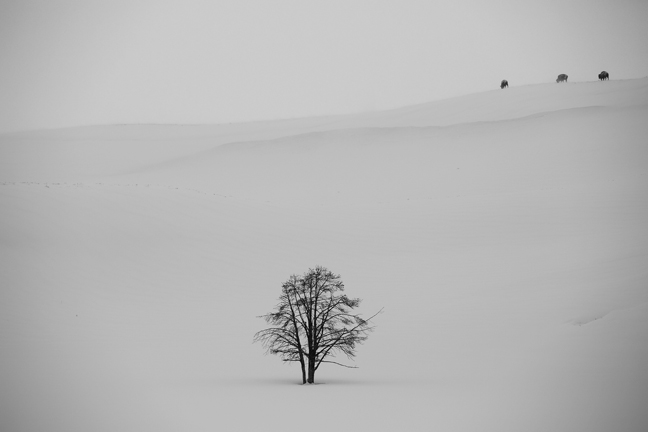

January 2017: Lone Tree and Bison, Yellowstone National Park
For five months every year, beginning in mid-November, the roads in Yellowstone National Park are snow packed and open only to foot traffic, snowmobiles and a variety of snowcoach configurations, including two 1953 Bombardiers, descendants of the original 1939 Canadian Snowbus patented by J. Armand Bombardier that resemble elongated red lady bugs.
These days access by motorized vehicles is strictly controlled. The current guidelines allow for 110 ‘transportation events’ daily, defined as one snowcoach or a group of up to 10 snowmobiles. Up to 50 transportation events may be groups of snowmobiles. During the week of January 30, when I visited the Park for five days, temperatures ranged from -16 to 28 °F and snow conditions varied from large delicate flakes to whiteout conditions that limited mobility and access. It was my first winter visit to the Park. The scenery was stunning, although there were more rules than necessary and the serenity was too often interrupted by parades of snowmobiles.
Bison are the most visible mammal species in the park and also a source of controversy. On February 2, 2017, Montana Gov. Steve Bullock lifted a temporary ban on the plan to kill up to 1,300 of the Park’s 5,500 bison that had been in place to protect bison that migrate out of the Park. The slaughter is intended to prevent bison from transmitting brucellosis to cattle, although no transmission from wild bison to livestock has ever been recorded. An agreement signed in 2000 by the state and the federal government set a population goal of 3,000 bison in the Park. Although, a bison eats about 24 pounds of forage a day, there are approximately 85,000 acres of grassland in the Park, so a lack of food can’t be the reason for controlling the population at that level. Even though the harvested meat feeds local indigenous communities, it’s difficult to emotionally separate the Park’s wild herd from those raised on the surrounding bison ranches if both are to be harvested.
Although the Park is home to ten packs of wolves and between 300-600 brown bears, most of the photographs you’ll see of these species are taken at the Grizzly & Wolf Discovery Center in West Yellowstone, adjacent to the Park’s western gate. Most photo groups spend a morning at the Center where pairs of bears are rotated through display areas for feeding and photographers hope for heavy snow that will obscure background fences from being visible in their pictures. There’s nothing ethically wrong with photographing captive or baited animals, but it often results in a credibility issue when those photographs are published without a disclaimer. The Center is a worthy non-profit with an excellent museum, just not a place to photograph realistic behaviors.
Within the Park, it’s easier to track wolves in the winter when their tracks are frozen into the snow, but all of the brown bears are hibernating. Yellowstone has a sordid past in bear management. For almost a century, beginning in the late 1800’s, brown bears gathered at night before bleachers packed with tourists to feed on garbage in open pit dumps behind Park hotels and, until the 1960s, visitors were allowed to feed begging opportunistic black bears along Park roads. This practice continued until 1970.
The Park is a much different place today and during the winter you only have to share it with 500-1,000 people a day, compared to July when almost 30,000 people visit the Park daily. Considering that the Park contains 3,472 square miles and all except the highest passes are open, that means that each winter visitor has an average of at least 347 square miles to him or herself. That’s a lot of real estate to explore in the world’s oldest national park.
©Rich Beckman
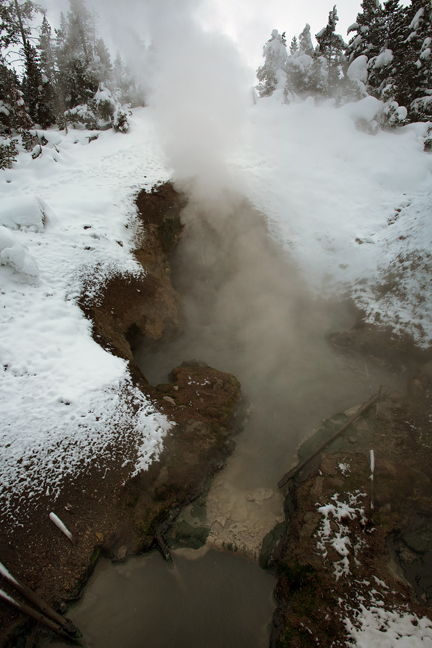

January 2017: Dragon's Mouth Spring, Yellowstone National Park
For five months every year, beginning in mid-November, the roads in Yellowstone National Park are snow packed and open only to foot traffic, snowmobiles and a variety of snowcoach configurations, including two 1953 Bombardiers, descendants of the original 1939 Canadian Snowbus patented by J. Armand Bombardier that resemble elongated red lady bugs.
These days access by motorized vehicles is strictly controlled. The current guidelines allow for 110 ‘transportation events’ daily, defined as one snowcoach or a group of up to 10 snowmobiles. Up to 50 transportation events may be groups of snowmobiles. During the week of January 30, when I visited the Park for five days, temperatures ranged from -16 to 28 °F and snow conditions varied from large delicate flakes to whiteout conditions that limited mobility and access. It was my first winter visit to the Park. The scenery was stunning, although there were more rules than necessary and the serenity was too often interrupted by parades of snowmobiles.
Bison are the most visible mammal species in the park and also a source of controversy. On February 2, 2017, Montana Gov. Steve Bullock lifted a temporary ban on the plan to kill up to 1,300 of the Park’s 5,500 bison that had been in place to protect bison that migrate out of the Park. The slaughter is intended to prevent bison from transmitting brucellosis to cattle, although no transmission from wild bison to livestock has ever been recorded. An agreement signed in 2000 by the state and the federal government set a population goal of 3,000 bison in the Park. Although, a bison eats about 24 pounds of forage a day, there are approximately 85,000 acres of grassland in the Park, so a lack of food can’t be the reason for controlling the population at that level. Even though the harvested meat feeds local indigenous communities, it’s difficult to emotionally separate the Park’s wild herd from those raised on the surrounding bison ranches if both are to be harvested.
Although the Park is home to ten packs of wolves and between 300-600 brown bears, most of the photographs you’ll see of these species are taken at the Grizzly & Wolf Discovery Center in West Yellowstone, adjacent to the Park’s western gate. Most photo groups spend a morning at the Center where pairs of bears are rotated through display areas for feeding and photographers hope for heavy snow that will obscure background fences from being visible in their pictures. There’s nothing ethically wrong with photographing captive or baited animals, but it often results in a credibility issue when those photographs are published without a disclaimer. The Center is a worthy non-profit with an excellent museum, just not a place to photograph realistic behaviors.
Within the Park, it’s easier to track wolves in the winter when their tracks are frozen into the snow, but all of the brown bears are hibernating. Yellowstone has a sordid past in bear management. For almost a century, beginning in the late 1800’s, brown bears gathered at night before bleachers packed with tourists to feed on garbage in open pit dumps behind Park hotels and, until the 1960s, visitors were allowed to feed begging opportunistic black bears along Park roads. This practice continued until 1970.
The Park is a much different place today and during the winter you only have to share it with 500-1,000 people a day, compared to July when almost 30,000 people visit the Park daily. Considering that the Park contains 3,472 square miles and all except the highest passes are open, that means that each winter visitor has an average of at least 347 square miles to him or herself. That’s a lot of real estate to explore in the world’s oldest national park.
©Rich Beckman
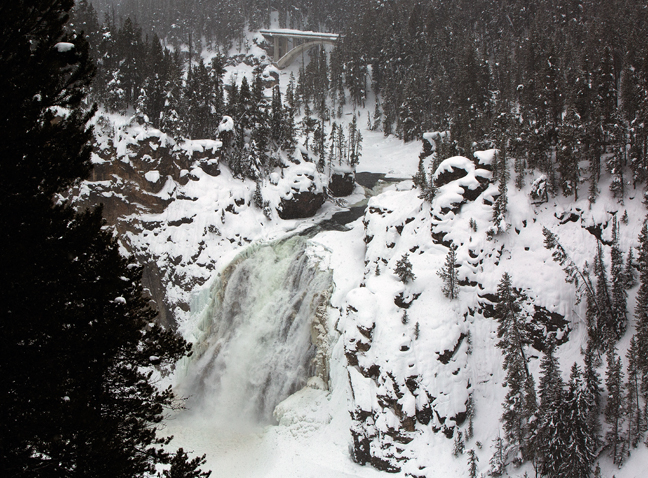

January 2017: Upper Falls, Yellowstone River, Grand Canyon of the Yellowstone and Chittenden Memorial Bridge, Yellowstone National Park
For five months every year, beginning in mid-November, the roads in Yellowstone National Park are snow packed and open only to foot traffic, snowmobiles and a variety of snowcoach configurations, including two 1953 Bombardiers, descendants of the original 1939 Canadian Snowbus patented by J. Armand Bombardier that resemble elongated red lady bugs.
These days access by motorized vehicles is strictly controlled. The current guidelines allow for 110 ‘transportation events’ daily, defined as one snowcoach or a group of up to 10 snowmobiles. Up to 50 transportation events may be groups of snowmobiles. During the week of January 30, when I visited the Park for five days, temperatures ranged from -16 to 28 °F and snow conditions varied from large delicate flakes to whiteout conditions that limited mobility and access. It was my first winter visit to the Park. The scenery was stunning, although there were more rules than necessary and the serenity was too often interrupted by parades of snowmobiles.
Bison are the most visible mammal species in the park and also a source of controversy. On February 2, 2017, Montana Gov. Steve Bullock lifted a temporary ban on the plan to kill up to 1,300 of the Park’s 5,500 bison that had been in place to protect bison that migrate out of the Park. The slaughter is intended to prevent bison from transmitting brucellosis to cattle, although no transmission from wild bison to livestock has ever been recorded. An agreement signed in 2000 by the state and the federal government set a population goal of 3,000 bison in the Park. Although, a bison eats about 24 pounds of forage a day, there are approximately 85,000 acres of grassland in the Park, so a lack of food can’t be the reason for controlling the population at that level. Even though the harvested meat feeds local indigenous communities, it’s difficult to emotionally separate the Park’s wild herd from those raised on the surrounding bison ranches if both are to be harvested.
Although the Park is home to ten packs of wolves and between 300-600 brown bears, most of the photographs you’ll see of these species are taken at the Grizzly & Wolf Discovery Center in West Yellowstone, adjacent to the Park’s western gate. Most photo groups spend a morning at the Center where pairs of bears are rotated through display areas for feeding and photographers hope for heavy snow that will obscure background fences from being visible in their pictures. There’s nothing ethically wrong with photographing captive or baited animals, but it often results in a credibility issue when those photographs are published without a disclaimer. The Center is a worthy non-profit with an excellent museum, just not a place to photograph realistic behaviors.
Within the Park, it’s easier to track wolves in the winter when their tracks are frozen into the snow, but all of the brown bears are hibernating. Yellowstone has a sordid past in bear management. For almost a century, beginning in the late 1800’s, brown bears gathered at night before bleachers packed with tourists to feed on garbage in open pit dumps behind Park hotels and, until the 1960s, visitors were allowed to feed begging opportunistic black bears along Park roads. This practice continued until 1970.
The Park is a much different place today and during the winter you only have to share it with 500-1,000 people a day, compared to July when almost 30,000 people visit the Park daily. Considering that the Park contains 3,472 square miles and all except the highest passes are open, that means that each winter visitor has an average of at least 347 square miles to him or herself. That’s a lot of real estate to explore in the world’s oldest national park.
©Rich Beckman
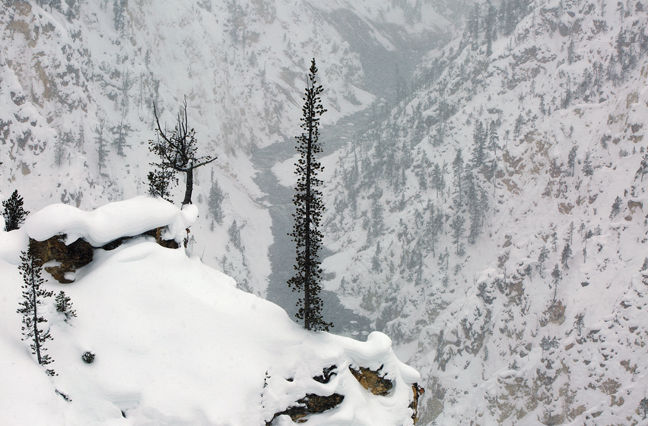

January 2017: Grand Canyon of the Yellowstone, Yellowstone National Park
For five months every year, beginning in mid-November, the roads in Yellowstone National Park are snow packed and open only to foot traffic, snowmobiles and a variety of snowcoach configurations, including two 1953 Bombardiers, descendants of the original 1939 Canadian Snowbus patented by J. Armand Bombardier that resemble elongated red lady bugs.
These days access by motorized vehicles is strictly controlled. The current guidelines allow for 110 ‘transportation events’ daily, defined as one snowcoach or a group of up to 10 snowmobiles. Up to 50 transportation events may be groups of snowmobiles. During the week of January 30, when I visited the Park for five days, temperatures ranged from -16 to 28 °F and snow conditions varied from large delicate flakes to whiteout conditions that limited mobility and access. It was my first winter visit to the Park. The scenery was stunning, although there were more rules than necessary and the serenity was too often interrupted by parades of snowmobiles.
Bison are the most visible mammal species in the park and also a source of controversy. On February 2, 2017, Montana Gov. Steve Bullock lifted a temporary ban on the plan to kill up to 1,300 of the Park’s 5,500 bison that had been in place to protect bison that migrate out of the Park. The slaughter is intended to prevent bison from transmitting brucellosis to cattle, although no transmission from wild bison to livestock has ever been recorded. An agreement signed in 2000 by the state and the federal government set a population goal of 3,000 bison in the Park. Although, a bison eats about 24 pounds of forage a day, there are approximately 85,000 acres of grassland in the Park, so a lack of food can’t be the reason for controlling the population at that level. Even though the harvested meat feeds local indigenous communities, it’s difficult to emotionally separate the Park’s wild herd from those raised on the surrounding bison ranches if both are to be harvested.
Although the Park is home to ten packs of wolves and between 300-600 brown bears, most of the photographs you’ll see of these species are taken at the Grizzly & Wolf Discovery Center in West Yellowstone, adjacent to the Park’s western gate. Most photo groups spend a morning at the Center where pairs of bears are rotated through display areas for feeding and photographers hope for heavy snow that will obscure background fences from being visible in their pictures. There’s nothing ethically wrong with photographing captive or baited animals, but it often results in a credibility issue when those photographs are published without a disclaimer. The Center is a worthy non-profit with an excellent museum, just not a place to photograph realistic behaviors.
Within the Park, it’s easier to track wolves in the winter when their tracks are frozen into the snow, but all of the brown bears are hibernating. Yellowstone has a sordid past in bear management. For almost a century, beginning in the late 1800’s, brown bears gathered at night before bleachers packed with tourists to feed on garbage in open pit dumps behind Park hotels and, until the 1960s, visitors were allowed to feed begging opportunistic black bears along Park roads. This practice continued until 1970.
The Park is a much different place today and during the winter you only have to share it with 500-1,000 people a day, compared to July when almost 30,000 people visit the Park daily. Considering that the Park contains 3,472 square miles and all except the highest passes are open, that means that each winter visitor has an average of at least 347 square miles to him or herself. That’s a lot of real estate to explore in the world’s oldest national park.
©Rich Beckman
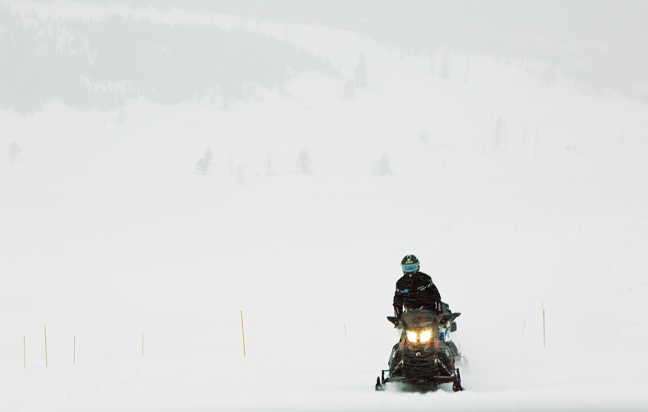

January 2017: Whiteout, North Rim Drive, Yellowstone National Park
For five months every year, beginning in mid-November, the roads in Yellowstone National Park are snow packed and open only to foot traffic, snowmobiles and a variety of snowcoach configurations, including two 1953 Bombardiers, descendants of the original 1939 Canadian Snowbus patented by J. Armand Bombardier that resemble elongated red lady bugs.
These days access by motorized vehicles is strictly controlled. The current guidelines allow for 110 ‘transportation events’ daily, defined as one snowcoach or a group of up to 10 snowmobiles. Up to 50 transportation events may be groups of snowmobiles. During the week of January 30, when I visited the Park for five days, temperatures ranged from -16 to 28 °F and snow conditions varied from large delicate flakes to whiteout conditions that limited mobility and access. It was my first winter visit to the Park. The scenery was stunning, although there were more rules than necessary and the serenity was too often interrupted by parades of snowmobiles.
Bison are the most visible mammal species in the park and also a source of controversy. On February 2, 2017, Montana Gov. Steve Bullock lifted a temporary ban on the plan to kill up to 1,300 of the Park’s 5,500 bison that had been in place to protect bison that migrate out of the Park. The slaughter is intended to prevent bison from transmitting brucellosis to cattle, although no transmission from wild bison to livestock has ever been recorded. An agreement signed in 2000 by the state and the federal government set a population goal of 3,000 bison in the Park. Although, a bison eats about 24 pounds of forage a day, there are approximately 85,000 acres of grassland in the Park, so a lack of food can’t be the reason for controlling the population at that level. Even though the harvested meat feeds local indigenous communities, it’s difficult to emotionally separate the Park’s wild herd from those raised on the surrounding bison ranches if both are to be harvested.
Although the Park is home to ten packs of wolves and between 300-600 brown bears, most of the photographs you’ll see of these species are taken at the Grizzly & Wolf Discovery Center in West Yellowstone, adjacent to the Park’s western gate. Most photo groups spend a morning at the Center where pairs of bears are rotated through display areas for feeding and photographers hope for heavy snow that will obscure background fences from being visible in their pictures. There’s nothing ethically wrong with photographing captive or baited animals, but it often results in a credibility issue when those photographs are published without a disclaimer. The Center is a worthy non-profit with an excellent museum, just not a place to photograph realistic behaviors.
Within the Park, it’s easier to track wolves in the winter when their tracks are frozen into the snow, but all of the brown bears are hibernating. Yellowstone has a sordid past in bear management. For almost a century, beginning in the late 1800’s, brown bears gathered at night before bleachers packed with tourists to feed on garbage in open pit dumps behind Park hotels and, until the 1960s, visitors were allowed to feed begging opportunistic black bears along Park roads. This practice continued until 1970.
The Park is a much different place today and during the winter you only have to share it with 500-1,000 people a day, compared to July when almost 30,000 people visit the Park daily. Considering that the Park contains 3,472 square miles and all except the highest passes are open, that means that each winter visitor has an average of at least 347 square miles to him or herself. That’s a lot of real estate to explore in the world’s oldest national park.
©Rich Beckman
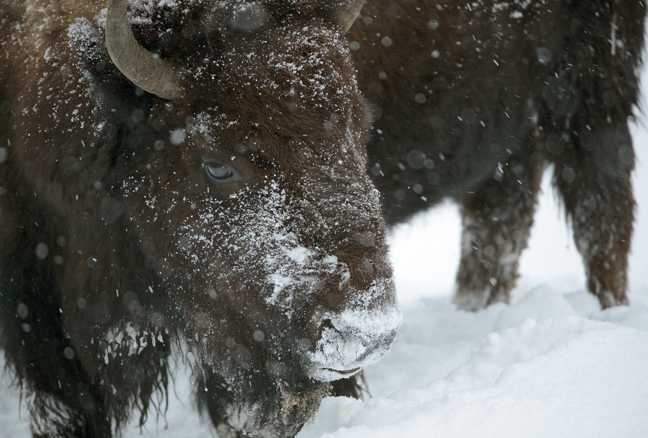

January 2017: Bison in Snowstorm, Yellowstone National Park
For five months every year, beginning in mid-November, the roads in Yellowstone National Park are snow packed and open only to foot traffic, snowmobiles and a variety of snowcoach configurations, including two 1953 Bombardiers, descendants of the original 1939 Canadian Snowbus patented by J. Armand Bombardier that resemble elongated red lady bugs.
These days access by motorized vehicles is strictly controlled. The current guidelines allow for 110 ‘transportation events’ daily, defined as one snowcoach or a group of up to 10 snowmobiles. Up to 50 transportation events may be groups of snowmobiles. During the week of January 30, when I visited the Park for five days, temperatures ranged from -16 to 28 °F and snow conditions varied from large delicate flakes to whiteout conditions that limited mobility and access. It was my first winter visit to the Park. The scenery was stunning, although there were more rules than necessary and the serenity was too often interrupted by parades of snowmobiles.
Bison are the most visible mammal species in the park and also a source of controversy. On February 2, 2017, Montana Gov. Steve Bullock lifted a temporary ban on the plan to kill up to 1,300 of the Park’s 5,500 bison that had been in place to protect bison that migrate out of the Park. The slaughter is intended to prevent bison from transmitting brucellosis to cattle, although no transmission from wild bison to livestock has ever been recorded. An agreement signed in 2000 by the state and the federal government set a population goal of 3,000 bison in the Park. Although, a bison eats about 24 pounds of forage a day, there are approximately 85,000 acres of grassland in the Park, so a lack of food can’t be the reason for controlling the population at that level. Even though the harvested meat feeds local indigenous communities, it’s difficult to emotionally separate the Park’s wild herd from those raised on the surrounding bison ranches if both are to be harvested.
Although the Park is home to ten packs of wolves and between 300-600 brown bears, most of the photographs you’ll see of these species are taken at the Grizzly & Wolf Discovery Center in West Yellowstone, adjacent to the Park’s western gate. Most photo groups spend a morning at the Center where pairs of bears are rotated through display areas for feeding and photographers hope for heavy snow that will obscure background fences from being visible in their pictures. There’s nothing ethically wrong with photographing captive or baited animals, but it often results in a credibility issue when those photographs are published without a disclaimer. The Center is a worthy non-profit with an excellent museum, just not a place to photograph realistic behaviors.
Within the Park, it’s easier to track wolves in the winter when their tracks are frozen into the snow, but all of the brown bears are hibernating. Yellowstone has a sordid past in bear management. For almost a century, beginning in the late 1800’s, brown bears gathered at night before bleachers packed with tourists to feed on garbage in open pit dumps behind Park hotels and, until the 1960s, visitors were allowed to feed begging opportunistic black bears along Park roads. This practice continued until 1970.
The Park is a much different place today and during the winter you only have to share it with 500-1,000 people a day, compared to July when almost 30,000 people visit the Park daily. Considering that the Park contains 3,472 square miles and all except the highest passes are open, that means that each winter visitor has an average of at least 347 square miles to him or herself. That’s a lot of real estate to explore in the world’s oldest national park.
©Rich Beckman
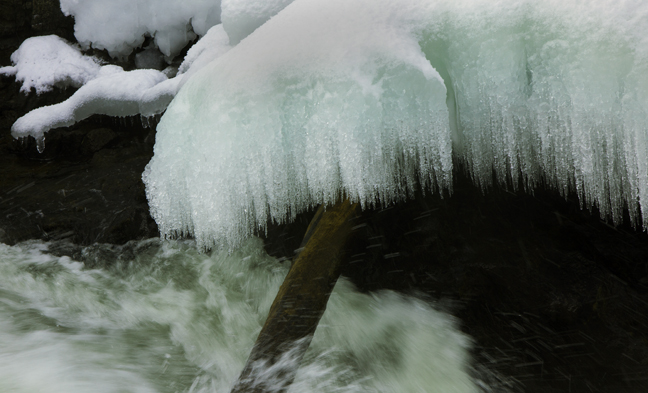

January 2017: Kepler Cascades, Yellowstone National Park
For five months every year, beginning in mid-November, the roads in Yellowstone National Park are snow packed and open only to foot traffic, snowmobiles and a variety of snowcoach configurations, including two 1953 Bombardiers, descendants of the original 1939 Canadian Snowbus patented by J. Armand Bombardier that resemble elongated red lady bugs.
These days access by motorized vehicles is strictly controlled. The current guidelines allow for 110 ‘transportation events’ daily, defined as one snowcoach or a group of up to 10 snowmobiles. Up to 50 transportation events may be groups of snowmobiles. During the week of January 30, when I visited the Park for five days, temperatures ranged from -16 to 28 °F and snow conditions varied from large delicate flakes to whiteout conditions that limited mobility and access. It was my first winter visit to the Park. The scenery was stunning, although there were more rules than necessary and the serenity was too often interrupted by parades of snowmobiles.
Bison are the most visible mammal species in the park and also a source of controversy. On February 2, 2017, Montana Gov. Steve Bullock lifted a temporary ban on the plan to kill up to 1,300 of the Park’s 5,500 bison that had been in place to protect bison that migrate out of the Park. The slaughter is intended to prevent bison from transmitting brucellosis to cattle, although no transmission from wild bison to livestock has ever been recorded. An agreement signed in 2000 by the state and the federal government set a population goal of 3,000 bison in the Park. Although, a bison eats about 24 pounds of forage a day, there are approximately 85,000 acres of grassland in the Park, so a lack of food can’t be the reason for controlling the population at that level. Even though the harvested meat feeds local indigenous communities, it’s difficult to emotionally separate the Park’s wild herd from those raised on the surrounding bison ranches if both are to be harvested.
Although the Park is home to ten packs of wolves and between 300-600 brown bears, most of the photographs you’ll see of these species are taken at the Grizzly & Wolf Discovery Center in West Yellowstone, adjacent to the Park’s western gate. Most photo groups spend a morning at the Center where pairs of bears are rotated through display areas for feeding and photographers hope for heavy snow that will obscure background fences from being visible in their pictures. There’s nothing ethically wrong with photographing captive or baited animals, but it often results in a credibility issue when those photographs are published without a disclaimer. The Center is a worthy non-profit with an excellent museum, just not a place to photograph realistic behaviors.
Within the Park, it’s easier to track wolves in the winter when their tracks are frozen into the snow, but all of the brown bears are hibernating. Yellowstone has a sordid past in bear management. For almost a century, beginning in the late 1800’s, brown bears gathered at night before bleachers packed with tourists to feed on garbage in open pit dumps behind Park hotels and, until the 1960s, visitors were allowed to feed begging opportunistic black bears along Park roads. This practice continued until 1970.
The Park is a much different place today and during the winter you only have to share it with 500-1,000 people a day, compared to July when almost 30,000 people visit the Park daily. Considering that the Park contains 3,472 square miles and all except the highest passes are open, that means that each winter visitor has an average of at least 347 square miles to him or herself. That’s a lot of real estate to explore in the world’s oldest national park.
©Rich Beckman
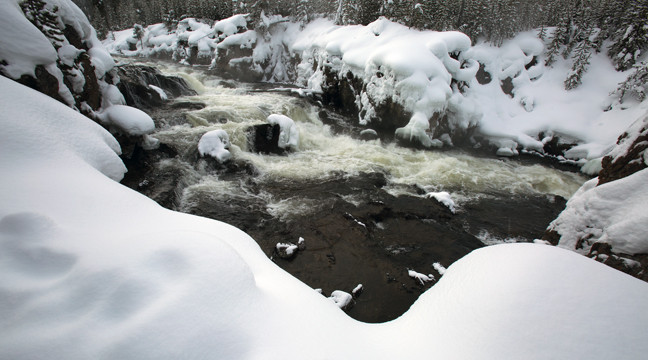

January 2017: Kepler Cascades, Yellowstone National Park
For five months every year, beginning in mid-November, the roads in Yellowstone National Park are snow packed and open only to foot traffic, snowmobiles and a variety of snowcoach configurations, including two 1953 Bombardiers, descendants of the original 1939 Canadian Snowbus patented by J. Armand Bombardier that resemble elongated red lady bugs.
These days access by motorized vehicles is strictly controlled. The current guidelines allow for 110 ‘transportation events’ daily, defined as one snowcoach or a group of up to 10 snowmobiles. Up to 50 transportation events may be groups of snowmobiles. During the week of January 30, when I visited the Park for five days, temperatures ranged from -16 to 28 °F and snow conditions varied from large delicate flakes to whiteout conditions that limited mobility and access. It was my first winter visit to the Park. The scenery was stunning, although there were more rules than necessary and the serenity was too often interrupted by parades of snowmobiles.
Bison are the most visible mammal species in the park and also a source of controversy. On February 2, 2017, Montana Gov. Steve Bullock lifted a temporary ban on the plan to kill up to 1,300 of the Park’s 5,500 bison that had been in place to protect bison that migrate out of the Park. The slaughter is intended to prevent bison from transmitting brucellosis to cattle, although no transmission from wild bison to livestock has ever been recorded. An agreement signed in 2000 by the state and the federal government set a population goal of 3,000 bison in the Park. Although, a bison eats about 24 pounds of forage a day, there are approximately 85,000 acres of grassland in the Park, so a lack of food can’t be the reason for controlling the population at that level. Even though the harvested meat feeds local indigenous communities, it’s difficult to emotionally separate the Park’s wild herd from those raised on the surrounding bison ranches if both are to be harvested.
Although the Park is home to ten packs of wolves and between 300-600 brown bears, most of the photographs you’ll see of these species are taken at the Grizzly & Wolf Discovery Center in West Yellowstone, adjacent to the Park’s western gate. Most photo groups spend a morning at the Center where pairs of bears are rotated through display areas for feeding and photographers hope for heavy snow that will obscure background fences from being visible in their pictures. There’s nothing ethically wrong with photographing captive or baited animals, but it often results in a credibility issue when those photographs are published without a disclaimer. The Center is a worthy non-profit with an excellent museum, just not a place to photograph realistic behaviors.
Within the Park, it’s easier to track wolves in the winter when their tracks are frozen into the snow, but all of the brown bears are hibernating. Yellowstone has a sordid past in bear management. For almost a century, beginning in the late 1800’s, brown bears gathered at night before bleachers packed with tourists to feed on garbage in open pit dumps behind Park hotels and, until the 1960s, visitors were allowed to feed begging opportunistic black bears along Park roads. This practice continued until 1970.
The Park is a much different place today and during the winter you only have to share it with 500-1,000 people a day, compared to July when almost 30,000 people visit the Park daily. Considering that the Park contains 3,472 square miles and all except the highest passes are open, that means that each winter visitor has an average of at least 347 square miles to him or herself. That’s a lot of real estate to explore in the world’s oldest national park.
©Rich Beckman
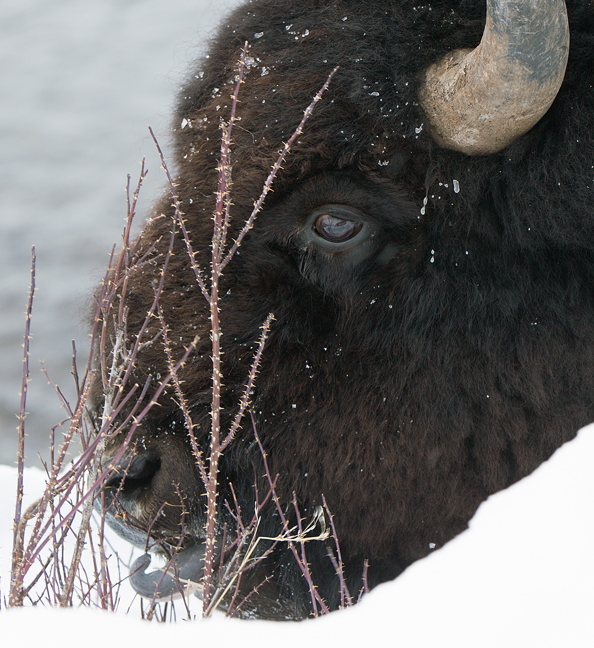

January 2017: Bison, Yellowstone National Park
For five months every year, beginning in mid-November, the roads in Yellowstone National Park are snow packed and open only to foot traffic, snowmobiles and a variety of snowcoach configurations, including two 1953 Bombardiers, descendants of the original 1939 Canadian Snowbus patented by J. Armand Bombardier that resemble elongated red lady bugs.
These days access by motorized vehicles is strictly controlled. The current guidelines allow for 110 ‘transportation events’ daily, defined as one snowcoach or a group of up to 10 snowmobiles. Up to 50 transportation events may be groups of snowmobiles. During the week of January 30, when I visited the Park for five days, temperatures ranged from -16 to 28 °F and snow conditions varied from large delicate flakes to whiteout conditions that limited mobility and access. It was my first winter visit to the Park. The scenery was stunning, although there were more rules than necessary and the serenity was too often interrupted by parades of snowmobiles.
Bison are the most visible mammal species in the park and also a source of controversy. On February 2, 2017, Montana Gov. Steve Bullock lifted a temporary ban on the plan to kill up to 1,300 of the Park’s 5,500 bison that had been in place to protect bison that migrate out of the Park. The slaughter is intended to prevent bison from transmitting brucellosis to cattle, although no transmission from wild bison to livestock has ever been recorded. An agreement signed in 2000 by the state and the federal government set a population goal of 3,000 bison in the Park. Although, a bison eats about 24 pounds of forage a day, there are approximately 85,000 acres of grassland in the Park, so a lack of food can’t be the reason for controlling the population at that level. Even though the harvested meat feeds local indigenous communities, it’s difficult to emotionally separate the Park’s wild herd from those raised on the surrounding bison ranches if both are to be harvested.
Although the Park is home to ten packs of wolves and between 300-600 brown bears, most of the photographs you’ll see of these species are taken at the Grizzly & Wolf Discovery Center in West Yellowstone, adjacent to the Park’s western gate. Most photo groups spend a morning at the Center where pairs of bears are rotated through display areas for feeding and photographers hope for heavy snow that will obscure background fences from being visible in their pictures. There’s nothing ethically wrong with photographing captive or baited animals, but it often results in a credibility issue when those photographs are published without a disclaimer. The Center is a worthy non-profit with an excellent museum, just not a place to photograph realistic behaviors.
Within the Park, it’s easier to track wolves in the winter when their tracks are frozen into the snow, but all of the brown bears are hibernating. Yellowstone has a sordid past in bear management. For almost a century, beginning in the late 1800’s, brown bears gathered at night before bleachers packed with tourists to feed on garbage in open pit dumps behind Park hotels and, until the 1960s, visitors were allowed to feed begging opportunistic black bears along Park roads. This practice continued until 1970.
The Park is a much different place today and during the winter you only have to share it with 500-1,000 people a day, compared to July when almost 30,000 people visit the Park daily. Considering that the Park contains 3,472 square miles and all except the highest passes are open, that means that each winter visitor has an average of at least 347 square miles to him or herself. That’s a lot of real estate to explore in the world’s oldest national park.
©Rich Beckman
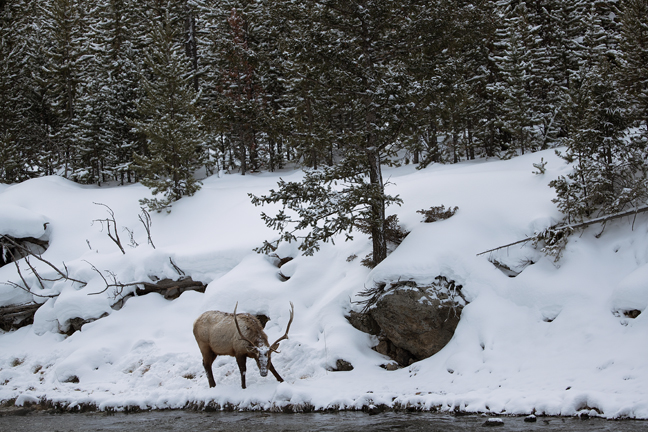

February 2017: Bull Elk, Yellowstone National Park
For five months every year, beginning in mid-November, the roads in Yellowstone National Park are snow packed and open only to foot traffic, snowmobiles and a variety of snowcoach configurations, including two 1953 Bombardiers, descendants of the original 1939 Canadian Snowbus patented by J. Armand Bombardier that resemble elongated red lady bugs.
These days access by motorized vehicles is strictly controlled. The current guidelines allow for 110 ‘transportation events’ daily, defined as one snowcoach or a group of up to 10 snowmobiles. Up to 50 transportation events may be groups of snowmobiles. During the week of January 30, when I visited the Park for five days, temperatures ranged from -16 to 28 °F and snow conditions varied from large delicate flakes to whiteout conditions that limited mobility and access. It was my first winter visit to the Park. The scenery was stunning, although there were more rules than necessary and the serenity was too often interrupted by parades of snowmobiles.
Bison are the most visible mammal species in the park and also a source of controversy. On February 2, 2017, Montana Gov. Steve Bullock lifted a temporary ban on the plan to kill up to 1,300 of the Park’s 5,500 bison that had been in place to protect bison that migrate out of the Park. The slaughter is intended to prevent bison from transmitting brucellosis to cattle, although no transmission from wild bison to livestock has ever been recorded. An agreement signed in 2000 by the state and the federal government set a population goal of 3,000 bison in the Park. Although, a bison eats about 24 pounds of forage a day, there are approximately 85,000 acres of grassland in the Park, so a lack of food can’t be the reason for controlling the population at that level. Even though the harvested meat feeds local indigenous communities, it’s difficult to emotionally separate the Park’s wild herd from those raised on the surrounding bison ranches if both are to be harvested.
Although the Park is home to ten packs of wolves and between 300-600 brown bears, most of the photographs you’ll see of these species are taken at the Grizzly & Wolf Discovery Center in West Yellowstone, adjacent to the Park’s western gate. Most photo groups spend a morning at the Center where pairs of bears are rotated through display areas for feeding and photographers hope for heavy snow that will obscure background fences from being visible in their pictures. There’s nothing ethically wrong with photographing captive or baited animals, but it often results in a credibility issue when those photographs are published without a disclaimer. The Center is a worthy non-profit with an excellent museum, just not a place to photograph realistic behaviors.
Within the Park, it’s easier to track wolves in the winter when their tracks are frozen into the snow, but all of the brown bears are hibernating. Yellowstone has a sordid past in bear management. For almost a century, beginning in the late 1800’s, brown bears gathered at night before bleachers packed with tourists to feed on garbage in open pit dumps behind Park hotels and, until the 1960s, visitors were allowed to feed begging opportunistic black bears along Park roads. This practice continued until 1970.
The Park is a much different place today and during the winter you only have to share it with 500-1,000 people a day, compared to July when almost 30,000 people visit the Park daily. Considering that the Park contains 3,472 square miles and all except the highest passes are open, that means that each winter visitor has an average of at least 347 square miles to him or herself. That’s a lot of real estate to explore in the world’s oldest national park.
©Rich Beckman
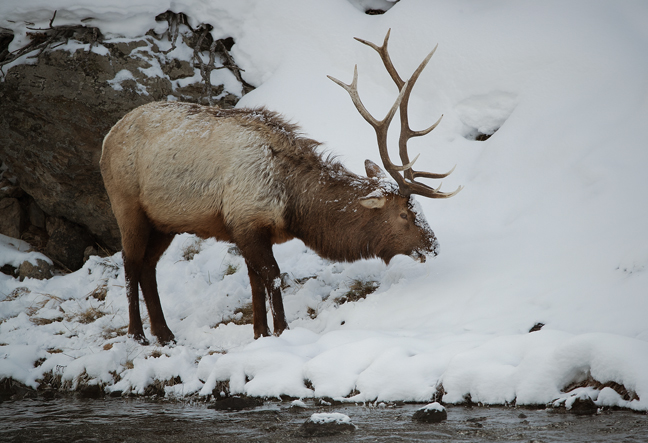

February 2017: Bull Elk, Yellowstone National Park
For five months every year, beginning in mid-November, the roads in Yellowstone National Park are snow packed and open only to foot traffic, snowmobiles and a variety of snowcoach configurations, including two 1953 Bombardiers, descendants of the original 1939 Canadian Snowbus patented by J. Armand Bombardier that resemble elongated red lady bugs.
These days access by motorized vehicles is strictly controlled. The current guidelines allow for 110 ‘transportation events’ daily, defined as one snowcoach or a group of up to 10 snowmobiles. Up to 50 transportation events may be groups of snowmobiles. During the week of January 30, when I visited the Park for five days, temperatures ranged from -16 to 28 °F and snow conditions varied from large delicate flakes to whiteout conditions that limited mobility and access. It was my first winter visit to the Park. The scenery was stunning, although there were more rules than necessary and the serenity was too often interrupted by parades of snowmobiles.
Bison are the most visible mammal species in the park and also a source of controversy. On February 2, 2017, Montana Gov. Steve Bullock lifted a temporary ban on the plan to kill up to 1,300 of the Park’s 5,500 bison that had been in place to protect bison that migrate out of the Park. The slaughter is intended to prevent bison from transmitting brucellosis to cattle, although no transmission from wild bison to livestock has ever been recorded. An agreement signed in 2000 by the state and the federal government set a population goal of 3,000 bison in the Park. Although, a bison eats about 24 pounds of forage a day, there are approximately 85,000 acres of grassland in the Park, so a lack of food can’t be the reason for controlling the population at that level. Even though the harvested meat feeds local indigenous communities, it’s difficult to emotionally separate the Park’s wild herd from those raised on the surrounding bison ranches if both are to be harvested.
Although the Park is home to ten packs of wolves and between 300-600 brown bears, most of the photographs you’ll see of these species are taken at the Grizzly & Wolf Discovery Center in West Yellowstone, adjacent to the Park’s western gate. Most photo groups spend a morning at the Center where pairs of bears are rotated through display areas for feeding and photographers hope for heavy snow that will obscure background fences from being visible in their pictures. There’s nothing ethically wrong with photographing captive or baited animals, but it often results in a credibility issue when those photographs are published without a disclaimer. The Center is a worthy non-profit with an excellent museum, just not a place to photograph realistic behaviors.
Within the Park, it’s easier to track wolves in the winter when their tracks are frozen into the snow, but all of the brown bears are hibernating. Yellowstone has a sordid past in bear management. For almost a century, beginning in the late 1800’s, brown bears gathered at night before bleachers packed with tourists to feed on garbage in open pit dumps behind Park hotels and, until the 1960s, visitors were allowed to feed begging opportunistic black bears along Park roads. This practice continued until 1970.
The Park is a much different place today and during the winter you only have to share it with 500-1,000 people a day, compared to July when almost 30,000 people visit the Park daily. Considering that the Park contains 3,472 square miles and all except the highest passes are open, that means that each winter visitor has an average of at least 347 square miles to him or herself. That’s a lot of real estate to explore in the world’s oldest national park.
©Rich Beckman
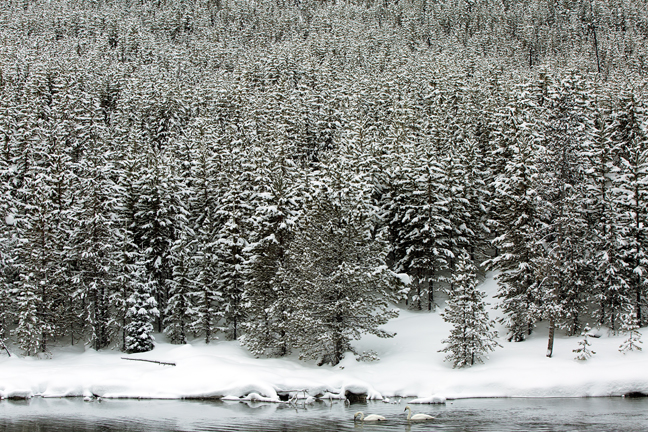

February 2017: Trumpeter Swans, Yellowstone National Park
For five months every year, beginning in mid-November, the roads in Yellowstone National Park are snow packed and open only to foot traffic, snowmobiles and a variety of snowcoach configurations, including two 1953 Bombardiers, descendants of the original 1939 Canadian Snowbus patented by J. Armand Bombardier that resemble elongated red lady bugs.
These days access by motorized vehicles is strictly controlled. The current guidelines allow for 110 ‘transportation events’ daily, defined as one snowcoach or a group of up to 10 snowmobiles. Up to 50 transportation events may be groups of snowmobiles. During the week of January 30, when I visited the Park for five days, temperatures ranged from -16 to 28 °F and snow conditions varied from large delicate flakes to whiteout conditions that limited mobility and access. It was my first winter visit to the Park. The scenery was stunning, although there were more rules than necessary and the serenity was too often interrupted by parades of snowmobiles.
Bison are the most visible mammal species in the park and also a source of controversy. On February 2, 2017, Montana Gov. Steve Bullock lifted a temporary ban on the plan to kill up to 1,300 of the Park’s 5,500 bison that had been in place to protect bison that migrate out of the Park. The slaughter is intended to prevent bison from transmitting brucellosis to cattle, although no transmission from wild bison to livestock has ever been recorded. An agreement signed in 2000 by the state and the federal government set a population goal of 3,000 bison in the Park. Although, a bison eats about 24 pounds of forage a day, there are approximately 85,000 acres of grassland in the Park, so a lack of food can’t be the reason for controlling the population at that level. Even though the harvested meat feeds local indigenous communities, it’s difficult to emotionally separate the Park’s wild herd from those raised on the surrounding bison ranches if both are to be harvested.
Although the Park is home to ten packs of wolves and between 300-600 brown bears, most of the photographs you’ll see of these species are taken at the Grizzly & Wolf Discovery Center in West Yellowstone, adjacent to the Park’s western gate. Most photo groups spend a morning at the Center where pairs of bears are rotated through display areas for feeding and photographers hope for heavy snow that will obscure background fences from being visible in their pictures. There’s nothing ethically wrong with photographing captive or baited animals, but it often results in a credibility issue when those photographs are published without a disclaimer. The Center is a worthy non-profit with an excellent museum, just not a place to photograph realistic behaviors.
Within the Park, it’s easier to track wolves in the winter when their tracks are frozen into the snow, but all of the brown bears are hibernating. Yellowstone has a sordid past in bear management. For almost a century, beginning in the late 1800’s, brown bears gathered at night before bleachers packed with tourists to feed on garbage in open pit dumps behind Park hotels and, until the 1960s, visitors were allowed to feed begging opportunistic black bears along Park roads. This practice continued until 1970.
The Park is a much different place today and during the winter you only have to share it with 500-1,000 people a day, compared to July when almost 30,000 people visit the Park daily. Considering that the Park contains 3,472 square miles and all except the highest passes are open, that means that each winter visitor has an average of at least 347 square miles to him or herself. That’s a lot of real estate to explore in the world’s oldest national park.
©Rich Beckman
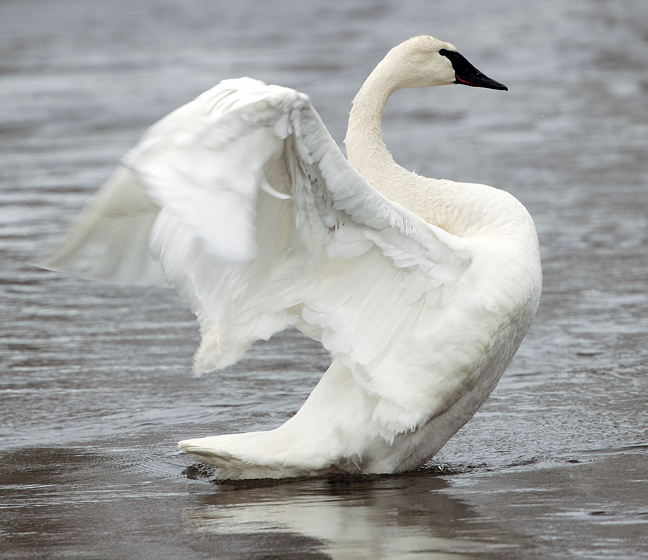

February 2017: Trumpeter Swan, Yellowstone National Park
For five months every year, beginning in mid-November, the roads in Yellowstone National Park are snow packed and open only to foot traffic, snowmobiles and a variety of snowcoach configurations, including two 1953 Bombardiers, descendants of the original 1939 Canadian Snowbus patented by J. Armand Bombardier that resemble elongated red lady bugs.
These days access by motorized vehicles is strictly controlled. The current guidelines allow for 110 ‘transportation events’ daily, defined as one snowcoach or a group of up to 10 snowmobiles. Up to 50 transportation events may be groups of snowmobiles. During the week of January 30, when I visited the Park for five days, temperatures ranged from -16 to 28 °F and snow conditions varied from large delicate flakes to whiteout conditions that limited mobility and access. It was my first winter visit to the Park. The scenery was stunning, although there were more rules than necessary and the serenity was too often interrupted by parades of snowmobiles.
Bison are the most visible mammal species in the park and also a source of controversy. On February 2, 2017, Montana Gov. Steve Bullock lifted a temporary ban on the plan to kill up to 1,300 of the Park’s 5,500 bison that had been in place to protect bison that migrate out of the Park. The slaughter is intended to prevent bison from transmitting brucellosis to cattle, although no transmission from wild bison to livestock has ever been recorded. An agreement signed in 2000 by the state and the federal government set a population goal of 3,000 bison in the Park. Although, a bison eats about 24 pounds of forage a day, there are approximately 85,000 acres of grassland in the Park, so a lack of food can’t be the reason for controlling the population at that level. Even though the harvested meat feeds local indigenous communities, it’s difficult to emotionally separate the Park’s wild herd from those raised on the surrounding bison ranches if both are to be harvested.
Although the Park is home to ten packs of wolves and between 300-600 brown bears, most of the photographs you’ll see of these species are taken at the Grizzly & Wolf Discovery Center in West Yellowstone, adjacent to the Park’s western gate. Most photo groups spend a morning at the Center where pairs of bears are rotated through display areas for feeding and photographers hope for heavy snow that will obscure background fences from being visible in their pictures. There’s nothing ethically wrong with photographing captive or baited animals, but it often results in a credibility issue when those photographs are published without a disclaimer. The Center is a worthy non-profit with an excellent museum, just not a place to photograph realistic behaviors.
Within the Park, it’s easier to track wolves in the winter when their tracks are frozen into the snow, but all of the brown bears are hibernating. Yellowstone has a sordid past in bear management. For almost a century, beginning in the late 1800’s, brown bears gathered at night before bleachers packed with tourists to feed on garbage in open pit dumps behind Park hotels and, until the 1960s, visitors were allowed to feed begging opportunistic black bears along Park roads. This practice continued until 1970.
The Park is a much different place today and during the winter you only have to share it with 500-1,000 people a day, compared to July when almost 30,000 people visit the Park daily. Considering that the Park contains 3,472 square miles and all except the highest passes are open, that means that each winter visitor has an average of at least 347 square miles to him or herself. That’s a lot of real estate to explore in the world’s oldest national park.
©Rich Beckman


February 2017: Midway Geyser Basin, Yellowstone National Park
For five months every year, beginning in mid-November, the roads in Yellowstone National Park are snow packed and open only to foot traffic, snowmobiles and a variety of snowcoach configurations, including two 1953 Bombardiers, descendants of the original 1939 Canadian Snowbus patented by J. Armand Bombardier that resemble elongated red lady bugs.
These days access by motorized vehicles is strictly controlled. The current guidelines allow for 110 ‘transportation events’ daily, defined as one snowcoach or a group of up to 10 snowmobiles. Up to 50 transportation events may be groups of snowmobiles. During the week of January 30, when I visited the Park for five days, temperatures ranged from -16 to 28 °F and snow conditions varied from large delicate flakes to whiteout conditions that limited mobility and access. It was my first winter visit to the Park. The scenery was stunning, although there were more rules than necessary and the serenity was too often interrupted by parades of snowmobiles.
Bison are the most visible mammal species in the park and also a source of controversy. On February 2, 2017, Montana Gov. Steve Bullock lifted a temporary ban on the plan to kill up to 1,300 of the Park’s 5,500 bison that had been in place to protect bison that migrate out of the Park. The slaughter is intended to prevent bison from transmitting brucellosis to cattle, although no transmission from wild bison to livestock has ever been recorded. An agreement signed in 2000 by the state and the federal government set a population goal of 3,000 bison in the Park. Although, a bison eats about 24 pounds of forage a day, there are approximately 85,000 acres of grassland in the Park, so a lack of food can’t be the reason for controlling the population at that level. Even though the harvested meat feeds local indigenous communities, it’s difficult to emotionally separate the Park’s wild herd from those raised on the surrounding bison ranches if both are to be harvested.
Although the Park is home to ten packs of wolves and between 300-600 brown bears, most of the photographs you’ll see of these species are taken at the Grizzly & Wolf Discovery Center in West Yellowstone, adjacent to the Park’s western gate. Most photo groups spend a morning at the Center where pairs of bears are rotated through display areas for feeding and photographers hope for heavy snow that will obscure background fences from being visible in their pictures. There’s nothing ethically wrong with photographing captive or baited animals, but it often results in a credibility issue when those photographs are published without a disclaimer. The Center is a worthy non-profit with an excellent museum, just not a place to photograph realistic behaviors.
Within the Park, it’s easier to track wolves in the winter when their tracks are frozen into the snow, but all of the brown bears are hibernating. Yellowstone has a sordid past in bear management. For almost a century, beginning in the late 1800’s, brown bears gathered at night before bleachers packed with tourists to feed on garbage in open pit dumps behind Park hotels and, until the 1960s, visitors were allowed to feed begging opportunistic black bears along Park roads. This practice continued until 1970.
The Park is a much different place today and during the winter you only have to share it with 500-1,000 people a day, compared to July when almost 30,000 people visit the Park daily. Considering that the Park contains 3,472 square miles and all except the highest passes are open, that means that each winter visitor has an average of at least 347 square miles to him or herself. That’s a lot of real estate to explore in the world’s oldest national park.
©Rich Beckman


February 2017: Panorama from Midway Geyser Basin, Yellowstone National Park
For five months every year, beginning in mid-November, the roads in Yellowstone National Park are snow packed and open only to foot traffic, snowmobiles and a variety of snowcoach configurations, including two 1953 Bombardiers, descendants of the original 1939 Canadian Snowbus patented by J. Armand Bombardier that resemble elongated red lady bugs.
These days access by motorized vehicles is strictly controlled. The current guidelines allow for 110 ‘transportation events’ daily, defined as one snowcoach or a group of up to 10 snowmobiles. Up to 50 transportation events may be groups of snowmobiles. During the week of January 30, when I visited the Park for five days, temperatures ranged from -16 to 28 °F and snow conditions varied from large delicate flakes to whiteout conditions that limited mobility and access. It was my first winter visit to the Park. The scenery was stunning, although there were more rules than necessary and the serenity was too often interrupted by parades of snowmobiles.
Bison are the most visible mammal species in the park and also a source of controversy. On February 2, 2017, Montana Gov. Steve Bullock lifted a temporary ban on the plan to kill up to 1,300 of the Park’s 5,500 bison that had been in place to protect bison that migrate out of the Park. The slaughter is intended to prevent bison from transmitting brucellosis to cattle, although no transmission from wild bison to livestock has ever been recorded. An agreement signed in 2000 by the state and the federal government set a population goal of 3,000 bison in the Park. Although, a bison eats about 24 pounds of forage a day, there are approximately 85,000 acres of grassland in the Park, so a lack of food can’t be the reason for controlling the population at that level. Even though the harvested meat feeds local indigenous communities, it’s difficult to emotionally separate the Park’s wild herd from those raised on the surrounding bison ranches if both are to be harvested.
Although the Park is home to ten packs of wolves and between 300-600 brown bears, most of the photographs you’ll see of these species are taken at the Grizzly & Wolf Discovery Center in West Yellowstone, adjacent to the Park’s western gate. Most photo groups spend a morning at the Center where pairs of bears are rotated through display areas for feeding and photographers hope for heavy snow that will obscure background fences from being visible in their pictures. There’s nothing ethically wrong with photographing captive or baited animals, but it often results in a credibility issue when those photographs are published without a disclaimer. The Center is a worthy non-profit with an excellent museum, just not a place to photograph realistic behaviors.
Within the Park, it’s easier to track wolves in the winter when their tracks are frozen into the snow, but all of the brown bears are hibernating. Yellowstone has a sordid past in bear management. For almost a century, beginning in the late 1800’s, brown bears gathered at night before bleachers packed with tourists to feed on garbage in open pit dumps behind Park hotels and, until the 1960s, visitors were allowed to feed begging opportunistic black bears along Park roads. This practice continued until 1970.
The Park is a much different place today and during the winter you only have to share it with 500-1,000 people a day, compared to July when almost 30,000 people visit the Park daily. Considering that the Park contains 3,472 square miles and all except the highest passes are open, that means that each winter visitor has an average of at least 347 square miles to him or herself. That’s a lot of real estate to explore in the world’s oldest national park.
©Rich Beckman
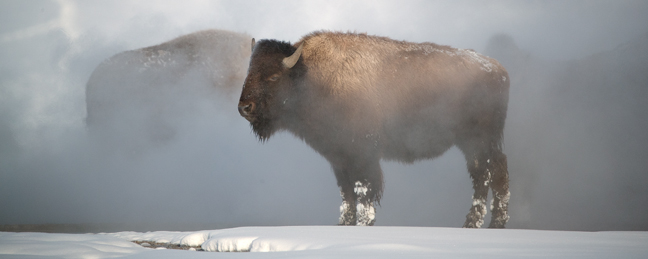

February 2017: Bison on the Barbie, Yellowstone National Park
For five months every year, beginning in mid-November, the roads in Yellowstone National Park are snow packed and open only to foot traffic, snowmobiles and a variety of snowcoach configurations, including two 1953 Bombardiers, descendants of the original 1939 Canadian Snowbus patented by J. Armand Bombardier that resemble elongated red lady bugs.
These days access by motorized vehicles is strictly controlled. The current guidelines allow for 110 ‘transportation events’ daily, defined as one snowcoach or a group of up to 10 snowmobiles. Up to 50 transportation events may be groups of snowmobiles. During the week of January 30, when I visited the Park for five days, temperatures ranged from -16 to 28 °F and snow conditions varied from large delicate flakes to whiteout conditions that limited mobility and access. It was my first winter visit to the Park. The scenery was stunning, although there were more rules than necessary and the serenity was too often interrupted by parades of snowmobiles.
Bison are the most visible mammal species in the park and also a source of controversy. On February 2, 2017, Montana Gov. Steve Bullock lifted a temporary ban on the plan to kill up to 1,300 of the Park’s 5,500 bison that had been in place to protect bison that migrate out of the Park. The slaughter is intended to prevent bison from transmitting brucellosis to cattle, although no transmission from wild bison to livestock has ever been recorded. An agreement signed in 2000 by the state and the federal government set a population goal of 3,000 bison in the Park. Although, a bison eats about 24 pounds of forage a day, there are approximately 85,000 acres of grassland in the Park, so a lack of food can’t be the reason for controlling the population at that level. Even though the harvested meat feeds local indigenous communities, it’s difficult to emotionally separate the Park’s wild herd from those raised on the surrounding bison ranches if both are to be harvested.
Although the Park is home to ten packs of wolves and between 300-600 brown bears, most of the photographs you’ll see of these species are taken at the Grizzly & Wolf Discovery Center in West Yellowstone, adjacent to the Park’s western gate. Most photo groups spend a morning at the Center where pairs of bears are rotated through display areas for feeding and photographers hope for heavy snow that will obscure background fences from being visible in their pictures. There’s nothing ethically wrong with photographing captive or baited animals, but it often results in a credibility issue when those photographs are published without a disclaimer. The Center is a worthy non-profit with an excellent museum, just not a place to photograph realistic behaviors.
Within the Park, it’s easier to track wolves in the winter when their tracks are frozen into the snow, but all of the brown bears are hibernating. Yellowstone has a sordid past in bear management. For almost a century, beginning in the late 1800’s, brown bears gathered at night before bleachers packed with tourists to feed on garbage in open pit dumps behind Park hotels and, until the 1960s, visitors were allowed to feed begging opportunistic black bears along Park roads. This practice continued until 1970.
The Park is a much different place today and during the winter you only have to share it with 500-1,000 people a day, compared to July when almost 30,000 people visit the Park daily. Considering that the Park contains 3,472 square miles and all except the highest passes are open, that means that each winter visitor has an average of at least 347 square miles to him or herself. That’s a lot of real estate to explore in the world’s oldest national park.
©Rich Beckman
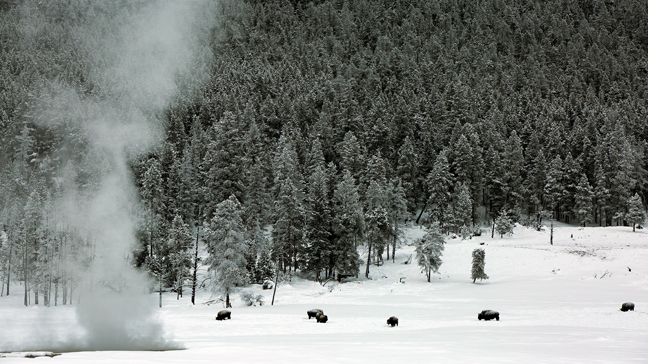

February 2017: Bison, Yellowstone National Park
For five months every year, beginning in mid-November, the roads in Yellowstone National Park are snow packed and open only to foot traffic, snowmobiles and a variety of snowcoach configurations, including two 1953 Bombardiers, descendants of the original 1939 Canadian Snowbus patented by J. Armand Bombardier that resemble elongated red lady bugs.
These days access by motorized vehicles is strictly controlled. The current guidelines allow for 110 ‘transportation events’ daily, defined as one snowcoach or a group of up to 10 snowmobiles. Up to 50 transportation events may be groups of snowmobiles. During the week of January 30, when I visited the Park for five days, temperatures ranged from -16 to 28 °F and snow conditions varied from large delicate flakes to whiteout conditions that limited mobility and access. It was my first winter visit to the Park. The scenery was stunning, although there were more rules than necessary and the serenity was too often interrupted by parades of snowmobiles.
Bison are the most visible mammal species in the park and also a source of controversy. On February 2, 2017, Montana Gov. Steve Bullock lifted a temporary ban on the plan to kill up to 1,300 of the Park’s 5,500 bison that had been in place to protect bison that migrate out of the Park. The slaughter is intended to prevent bison from transmitting brucellosis to cattle, although no transmission from wild bison to livestock has ever been recorded. An agreement signed in 2000 by the state and the federal government set a population goal of 3,000 bison in the Park. Although, a bison eats about 24 pounds of forage a day, there are approximately 85,000 acres of grassland in the Park, so a lack of food can’t be the reason for controlling the population at that level. Even though the harvested meat feeds local indigenous communities, it’s difficult to emotionally separate the Park’s wild herd from those raised on the surrounding bison ranches if both are to be harvested.
Although the Park is home to ten packs of wolves and between 300-600 brown bears, most of the photographs you’ll see of these species are taken at the Grizzly & Wolf Discovery Center in West Yellowstone, adjacent to the Park’s western gate. Most photo groups spend a morning at the Center where pairs of bears are rotated through display areas for feeding and photographers hope for heavy snow that will obscure background fences from being visible in their pictures. There’s nothing ethically wrong with photographing captive or baited animals, but it often results in a credibility issue when those photographs are published without a disclaimer. The Center is a worthy non-profit with an excellent museum, just not a place to photograph realistic behaviors.
Within the Park, it’s easier to track wolves in the winter when their tracks are frozen into the snow, but all of the brown bears are hibernating. Yellowstone has a sordid past in bear management. For almost a century, beginning in the late 1800’s, brown bears gathered at night before bleachers packed with tourists to feed on garbage in open pit dumps behind Park hotels and, until the 1960s, visitors were allowed to feed begging opportunistic black bears along Park roads. This practice continued until 1970.
The Park is a much different place today and during the winter you only have to share it with 500-1,000 people a day, compared to July when almost 30,000 people visit the Park daily. Considering that the Park contains 3,472 square miles and all except the highest passes are open, that means that each winter visitor has an average of at least 347 square miles to him or herself. That’s a lot of real estate to explore in the world’s oldest national park.
©Rich Beckman